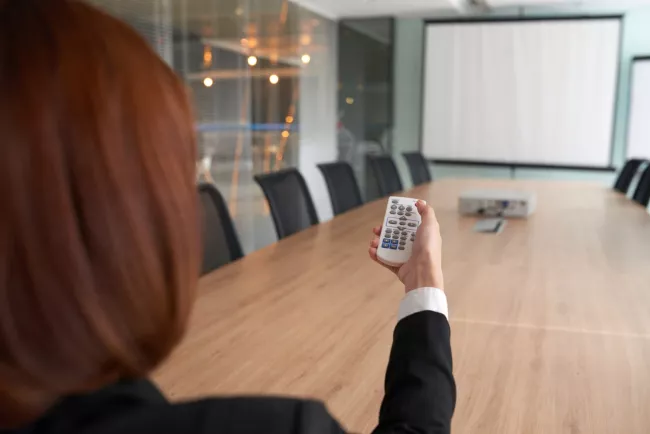The perfect conference room is a thoughtfully designed space for productive meetings and presentations. Its success depends on proper equipment, comfortable furniture, and smart event planning. Renting a conference room is especially important for business events, formal negotiations, and training sessions. Common issues include poor acoustics, outdated technology, bad lighting, and ineffective ventilation. All of these can be addressed by considering the key characteristics of the space, its design, and technical features.
Key Characteristics of a Perfect Conference Room
When choosing a space for corporate, educational, or creative events, you need to focus on essential criteria. For most companies, the ideal conference room supports productive communication, inspires new ideas, and helps create high-quality materials. One of the most important factors is the layout of tables and chairs, as well as access to modern equipment. A stylish conference room combines aesthetics and functionality, helping every participant feel confident and comfortable.
Here’s what to look for:
- Room size and proportions. The number of participants may vary, so the space should allow for free movement and proper spacing between rows.
- Good acoustics. Clear sound without echo helps the audience absorb information more easily.
- Modern equipment. Quick connection to multimedia, screens, or streaming systems.
- Balanced lighting. Natural light and adjustable lighting fixtures to match the event format — from darkened presentations to discussion sessions.
- Optimal ventilation. Maintains a fresh indoor climate without drafts or stuffiness.
Technical Equipment of a Conference Room
To ensure successful events, a conference room must be equipped with up-to-date devices and software. Whether online or offline, communication relies on reliable tools like projectors, laptops, and video systems. Microphones should deliver clean sound to everyone in the room. Modern tools include touch panels, smartboards, and real-time collaboration services.
Essential equipment:
- Wired and wireless microphones
- Audio systems with adjustable volume zones
- Projectors and displays for presentations
- Cables and adapters for device connectivity
- Recording and online broadcasting systems
Ergonomics and Comfort
Successful events depend not only on equipment but also on smart furniture arrangement, enough space to move around, and conditions that promote focus. Conference room comfort includes adjustable chairs with back support, tables of proper height, and flexible layouts. Style also matters — a stylish space leaves a good impression on clients and partners.
Useful tips:
- Choose furniture based on the type of event: rows of chairs for presentations, round or U-shaped tables for discussions
- Leave at least 60–70 cm between rows for easy movement
- Use cushioned chairs with tilt adjustment if possible
Design and Atmosphere
A good balance of aesthetics and functionality creates a productive and motivating environment. The room design should reflect the office or brand identity while adding a creative touch. A well-designed space supports focus, creativity, and collaboration.
Design elements to consider:
- Color scheme. Light tones make the room look bigger; bright accents add personality — paintings, panels, logos
- Sound-absorbing materials. Carpets, wall and ceiling panels
- Flexible interior. Mobile partitions, lightweight tables and chairs for quick reconfiguration
Renting a Conference Room for Different Events
Whether you're organizing a training session, seminar, or business meeting, renting a conference room is a quick way to access the right conditions. Renting also allows you to match the location with the event format: a downtown office for business talks, or an out-of-town venue for team building and networking.
What to consider:
- Location. Easy to reach, with parking available
- Technical setup. Does it meet the event's needs?
- Accommodation and catering. Important for multi-day events
Conference Room for Presentations
Public speaking and product demos require rooms that meet technical and ergonomic standards. Clear visuals, crisp audio, and good sightlines are essential. Rental often includes tech support and on-site assistance.
Key requirements:
- Adjustable professional lighting
- Large screen or projection area
- Pre-event sound system testing
Renting a Room for Business Events
Organizing conferences, roundtables, or workshops often involves planning the space, equipment, and schedule. It’s essential to coordinate the event scenario, timing, seating, and additional services like translation booths or coffee break areas.
Recommendations:
- Set up a registration area for guests
- Add signs and navigation boards
- Test all equipment in advance
- Prepare and distribute event materials
Technology for a Modern Conference Room
Digital platforms are now essential for events. Companies need integrated systems — audiovisual support, remote access, automatic lighting and climate control. Reliable Wi-Fi, live streaming, and cross-platform capabilities are a must.
Audiovisual Equipment
To ensure smooth meetings, your equipment should include:
- High-brightness projectors
- Large-format or interactive panels
- Tunable acoustic systems
- Smart controls for light and climate
Video Conferencing Systems
Online meetings save time and connect international teams. Reliable tech is essential:
- High-resolution wide-angle cameras
- Quality microphones
- Powerful computers with licensed software
- Stable high-speed internet
Conclusion
The perfect conference room brings together design, technology, and comfort. Choose a space that fits your audience, event goals, and technical requirements. A well-equipped and stylish room is a versatile solution for training, meetings, and presentations — helping your business grow and succeed.
